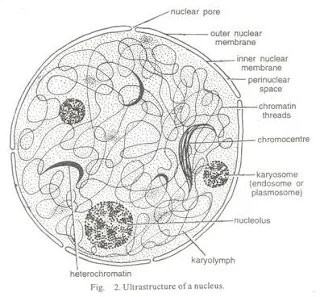The Nucleus
Nucleus was discovered by “Robert Brown”.
Nucleus has following parts -
Nuclear envelope- This is made of two parallel membrane .Space between membranes is
known as Perinuclear space .Nuclear
envelope separates material inside nucleus from cytoplasm. In nuclear envelope
some minute pores are present i.e nuclear pores. These acts as passage for RNAs
and proteins between nucloplasm and cytoplasm.
Nucleoplasm –
Fluid inside nucleus is called as “Nucleoplasm”. This contains “Nucleolus and Chromatins”.
Nucleolus
– These are spherical bodies found in
nucleoplasm. These were discovered by “Fontana”. Nucleolus is not a membrane
bound structure. It is a site of ribosomal RNA synthesis. Numerous nucleoli are
found in cells actively carrying out protein synthesis.
Chromosomes: These threads like structures are made of nucleoprotein (DNA+Histone proteins) i.e. chromatin. Chromosomes carry parental
traits into offspring .
Transmission of traits from one generation
to next generation is known as “Inheritence”.
Functions of Nucleus-
·
Nucleus
controls all the activities in cell.
·
In nucleus
,process of DNA –replication ,transcription (formation of RNA from DNA) occurs.
·
In
nucleolus ribosomal RNA synthesis occurs.
·
Chromosomes
carry traits from one generation into next generation.





